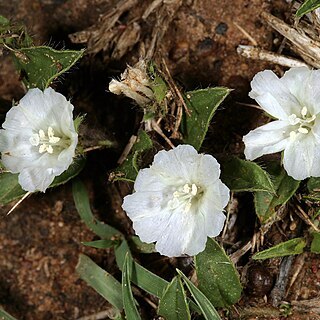Suffruticose perennial, brownish hairy. Stems several, prostrate to suberect, up to 300 mm long. Leaves ovate to oblong, sessile or shortly petiolate, 5-25 mm long, apex obtuse or subacute, base rounded to ± narrowed or truncate. Flowers axillary, solitary, subsessile; pedicel up to 10 mm long; bracteoles 2, lanceolate, shorter than sepals. Sepals broadly lanceolate, acute, 4-9 mm long. Corolla broadly funnel-shaped, pinkish white, 6-12 mm long; style branched nearly from base; stigmas subpeltate, bilobed. Flowering time Sept.-May. Fruit a subglobose capsule, ± 5 mm wide. Seeds black, smooth.
Subshrub; stems, leaves, pedicels, calyx and midpetaline bands of corolla covered with stiff, rusty brown, appressed to patent hairs. Stems procumbent or decumbent. Leaves with blade ovate to narrowly ovate, 5-25 x 3-12 mm, base rounded to truncate, apex obtuse to acute, strigose on both surfaces. Flowers: always solitary, sessile, rarely pedicellate; style bifid with 2 subpeltate, bilobed stigmas; calyx lobes 7-10 mm long, ciliate with bulbous-based hairs; corolla ± 10 mm long, pinkish white; Sep.-Apr. Fruit subglobose, ± 5 mm in diameter, usually crowned with a tuft of hairs.
Prostrate to suberect subshrub. Flowers always solitary, sessile or very rarely pedicellate. Calyx 7-10 mm long, sepals ciliate with bulbous-based hairs. Corolla ± 10 mm long. Pubescence usually distinctly brown or fer-rugineous with bulbous-based hairs. Flowers pinkish white.

